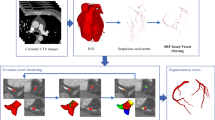Abstract
This work presents a new method for segmenting coronary arteries automatically in computed tomography angiography (CTA) data sets. The method automatically isolates heart and coronary arteries from surrounding structures and search for the probable location of coronary arteries by 3D region growing. Based on the dilation of the probable location, discrete wavelet transformation (DWT) and λ – mean operation complete accurate detection of coronary arties. Finally, the proposed method is tested on clinical CTA data-sets. The results on clinical datasets show that the proposed method is able to extract each branch of arteries when comparing to commercial software GE Healthcare and delineated ground truth.








Similar content being viewed by others
References
Mandal, I., and Sairam, N., Accurate Prediction of Coronary Artery Disease Using Reliable Diagnosis System. Journal of Medical Systems 36(5):3353–3373, October 2012.
Frangi, A. F., Niessen, W. J., Vincken, K. L., and Viergever, M. A., “Multiscale Vessel Enhancement Filtering”, Proceeding International Conference on Medical Image Computing Computer-Assisted Intervention-MICCAI 1998. LNCS 1496:130–137, 1998.
Shikata, H., McLennan, G., Hoffman, E. A., and Sonka, M., Segmentation of Pulmonary Vascular Tree From Thoracic 3D CT Images. International Journal of Biomedical Imaging 2009(636240):11, 2009. doi:10.1155/2009/636240.
Kirbas, C., and Quek, F., A Review of Vessel Extraction Techniques and Algorithms. ACM Comput. Surv. 36(2):81–121, 2004.
D. Nain, A. Yezzi, and G. Turk, “Vessel Segmentation Using a Driven Flow Shape”, Proceeding International Conference on Medical Image Computing Computer-Assisted Intervention-MICCAI 2004, LNCS 3216, pp. 51–59, 2004
Yang, Y., Tannenbaum, A., and Giddens, D., Knowledge-Based 3D Segmentation and Reconstruction of Coronary Arteries Using CT Images. IEEE Conference on Engineering in Medicine and Biology Society, Atlanta, 2004.
Chan, T. F., and Vese, L. A., Active Contours without Edges. IEEE Transactions on Image Processing 10:266–277, 2001.
Brox, T., and Weickert, J., Level Set Segmentation with Multiple Regions. IEEE Transactions on Image Processing 15(10):3213–3218, 2006.
Pratt, W. K., Digital Image Processing 4th Edition. Wiley, Los Altos, 2007.
Y. Yang, A. Tannenbaum, D. Giddens, and A. Stillman, “Automatic Segmentation of Coronary Arteries using Bayesian Driven Implict Surfaces,” 4 th IEEE International Symposium on Biomedical Imaging (ISBI), pp.189-192, 2007
Wang, L., He, L., Mishra, A., and Li, C., Active Contours Driven by Local Gaussian Distribution Fitting Energy. Journal of Signal Processing 89(12):2435–2447, 2009.
Manniesing, R., Schaap, M., Rozie, S., Hameeteman, R., Vukadinovic, D., Lugt, A. V. D., and Niessen, W., Robust CTA Lumen Segmentation of the Atherosclerotic Carotid Artery Bifurcation in a Large Patient Population. Medical Image Analysis 14(6):759–769, 2010.
Tek, H., Zheng, Y., Gulsun, M. A., and Funka-Lea, G., An Automatic System For Segmenting Coronary Arteries from CTA. Proceeding International Conference on Medical Image Computing Computer-Assisted Intervention-MICCAI-CVII 2011:47–54, 2011.
Won, J.-H., Rosenberg, J., Rubin, G. D., and Napel, S., Uncluttered single-image visualization of the abdominal aortic vessel tree: Method and evaluation. Medical Physics 36(11), 2009.
Kaiqiong, S., Zhen, C., Shaofeng, J., and Yu, W., Morphological Multiscale Enhancement, Fuzzy Filter and Watershed for Vascular Tree Extraction in Angiogram. Journal of Medical Systems 35(5):811–824, 2011.
Daubechies, I., Orthogonal Bases of Compactly Supported Wavelets. Communications on Pure and Applied Mathematics 41:909–996, 1988.
Mallat, S., A Theory for Multiresolution Signal Decomposition: the Wavelet Respresentation. IEEE Transactions on Pattern Analysis and Machine Intelligence 11:674–693, 1989.
Burrus, C. S., Gopinath, R. A., and Gao, H., Introduction to Wavelet Theory and Its Application. Prentice-Hall, New Jersey, 1998.
Pavlidis, T., and Liow, Y.-T., Integrating Region Growing and Edge Detection. IEEE Transactions on Pattern Analysis and Machine Intelligence 12:225–233, 1990.
User, M., Local Linear Transforms for Texture Measurements. Signal Processing 11(1):61–79, July, 1986.
Chang, T., and Jay Kuo, C.-C., Texture Analysis and Classification with Tree-Structured Wavelet Transform. IEEE Transactions on Image Processing 2(4):429–441, 1993.
Unser, M., Texture Classification and Segmentation Using Wavelet Frames. IEEE Transactions on Image Processing 4(11):1549–1560, 1995.
Wang, Z.-Z., and Yong, J.-H., Texture Analysis Classification and Segmentation with Linear Regression Model Based on Wavelet Transform. IEEE Transactions on Image Processing 17(8):1421–1430, 2008.
Acknowledgments
This work was in part supported by the National Science Council, Taiwan (R.O.C.), under the NSC grant: NSC 98-2221-E-002-098-MY3.
Author information
Authors and Affiliations
Corresponding author
Additional information
This article is part of the Topical Collection on Systems-Level Quality Improvement
Rights and permissions
About this article
Cite this article
Chen, ST., Hung, PK., Lin, MS. et al. DWT-Based Segmentation Method for Coronary Arteries. J Med Syst 38, 55 (2014). https://doi.org/10.1007/s10916-014-0055-8
Received:
Accepted:
Published:
DOI: https://doi.org/10.1007/s10916-014-0055-8




